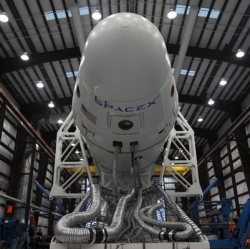
As the year draws to a close, it’s worth glancing over our shoulder. What technologies and themes were brightest in 2014? Read on. (And keep in mind, attempting such a summation is ambitious to the extreme, let us know what we missed!)
Illumina Breaks DNA Reading ‘Sound Barrier’
In January, Illumina announced that their latest DNA sequencing machine can transcribe 18,000 human genomes a year for $1,000 each, down from hundreds of millions a decade ago. The $1,000 genome enables broad genomic studies that may yield insights into the origins of disease.
Mars Ambitions, Reusable Rockets, and 3D Space Printers
According to Elon Musk, billionaire space entrepreneur, humans have to become a multi-planetary species if we’re to survive. Musk hopes to begin colonizing Mars in the 2030s, but we’ll have to first reduce the cost of space travel. He believes reusable rockets, which the firm began testing in 2014, may slash launch costs by a factor of 100.
Virtual Reality Attracts Big Bets
thanks to its virtual reality Rift headset (still under development), 18-month-old Oculus was acquired by Facebook for a whopping $2 billion. Google made its own VR contribution, a stripped down, smartphone-based cardboard headset, while Oculus worked with Samsung to finish its more polished smartphone-based Gear VR goggles (now on sale).
Body 2.0: Drop-of-Blood Diagnosis and Skin-Based Stem Cells
Portable health devices are approaching the Star Trek tricorder in size and cability. The XPRIZE Nokia Sensing XCHALLENGE winning device, rHEALTH, is a handheld machine that can diagnose hundreds of diseases using 1,500 times less blood. Cheap, regular testing may help doctors catch and treat disease before it’s too late. And devices may shrink more. Google, for example, unveiled experimental contact lenses to measure blood glucose in diabetics.
Regenerative medicine gained steam too. Once the poster child for controversy, stem cells need no longer be sourced from embryos. Cutting-edge techniques that coax normal skin cells into pluripotent stem cells, which are able to become any other cell and may help regenerate damaged tissue, began human trials in patients with macular degeneration in 2014.
3D Printing Moves Past Peak Hype, Approaches Real Revolution
Consumer 3D printing hype hit fever pitch last year. It seemed at-home replicators would soon grace the average desktop. The hype was driven by real advances, plummeting costs and big box store offerings, it just overshot the mark (as it tends to). Most consumer printers still lack resolution, only print plastic, are slow, and don’t have a killer application.
The Robots Are Coming: Drones, Driverless Cars, and Space Probes
Today’s drones with basic AI onboard are cheap, self-stabilizing, and can even follow you with an HD camera. The cheapest minidrones can do flips off your palm for $30. Drones are already aiding law enforcement and the military, and depending on regulations due this month, may one day be big business, delivering a six-pack of beer or online orders.
Google’s driverless cars hit 700,000 miles accident free, graduated from highways to city streets, and new models did away with the steering wheel and gas and brake pedals. Big automakers stumbled over each other to announce their own robot car program.
Artificial Intelligence Advances, Fuels Controversy
Not so long ago, artificial intelligence was a word to be avoided, now it’s back in vogue. Narrow AI, the kind that learns and performs specialized tasks, doubled its ability to recognize images this year. IBM announced a new brain-inspired chip and invested $1 billion in its Jeopardy-champ AI system Watson. Siri’s inventors funded a project to develop a next-gen virtual assistant to handle the tasks Siri (and others) still struggle with. Google, Facebook, and others continued collecting AI researchers like baseball cards. And algorithms broke news before humans.
Billions Poised to Come Online
Nearly two-thirds of the planet lacks internet. But likely not for too much longer. Developments in 2014 suggested that over four billion new people will get online in the coming years.
Mozilla announced a $25 smartphone, as cheap as a standard cellphone. Google’s experimental internet balloons may girdle the planet as soon as next year, and the firm announced a $1 billion investment in a future global internet satellite network. Meanwhile, Facebook aims to develop solar-powered internet drones able to stay aloft for extended periods and deliver internet to infrastructure-poor areas.
See You in 2015…
What does it all mean? It means momentum continues to build; 2015 will have its own share of awe-inspiring developments and breakthroughs; and next year, we expect to take an even bigger step toward the future. Stay tuned.
